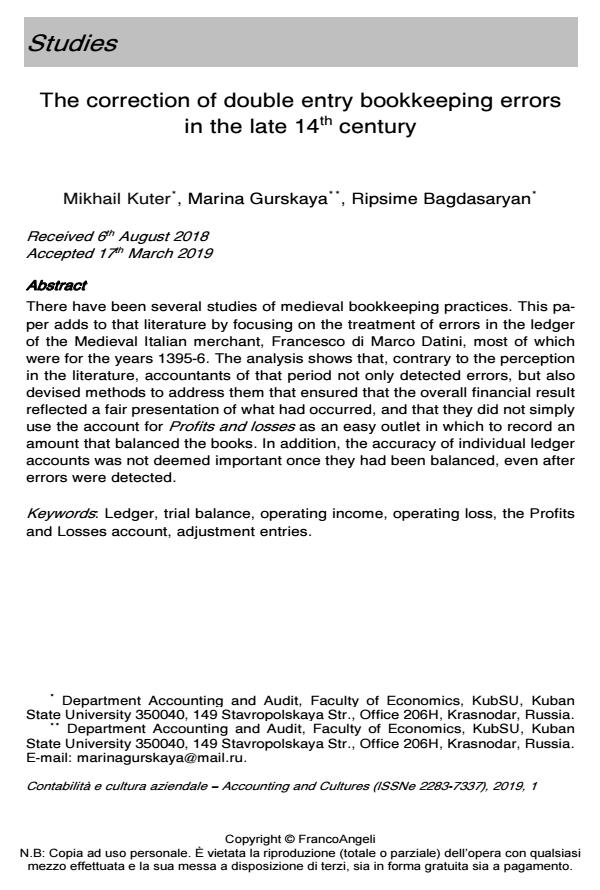The correction of double entry bookkeeping errors in the late 14th century
Journal title CONTABILITÀ E CULTURA AZIENDALE
Author/s Mikhail Kuter, Marina Gurskaya, Ripsime Bagdasaryan
Publishing Year 2019 Issue 2019/1
Language English Pages 24 P. 7-30 File size 451 KB
DOI 10.3280/CCA2019-001002
DOI is like a bar code for intellectual property: to have more infomation
click here
Below, you can see the article first page
If you want to buy this article in PDF format, you can do it, following the instructions to buy download credits

FrancoAngeli is member of Publishers International Linking Association, Inc (PILA), a not-for-profit association which run the CrossRef service enabling links to and from online scholarly content.
There have been several studies of medieval bookkeeping practices. This paper adds to that literature by focusing on the treatment of errors in the ledger of the Medieval Italian merchant, Francesco di Marco Datini, most of which were for the years 1395-6. The analysis shows that, contrary to the perception in the literature, accountants of that period not only detected errors, but also devised methods to address them that ensured that the overall financial result reflected a fair presentation of what had occurred, and that they did not simply use the account for Profits and losses as an easy outlet in which to record an amount that balanced the books. In addition, the accuracy of individual ledger accounts was not deemed important once they had been balanced, even after errors were detected.
Keywords: Ledger, trial balance, operating income, operating loss, the Profits and Losses account, adjustment entries.
- Digital Science 2019 Dmitry Aleinikov, pp.374 (ISBN:978-3-030-37736-6)
- The Business Needs that Drove the Emergence of Double Entry: In Defense of Pacioli, again … It is Time to Remove Those Dark Glasses Alan Sangster, in Accounting Historians Journal /2022 pp.93
DOI: 10.2308/AAHJ-2021-022 - Digitalising medieval accounting research: Andrea Barbarigo’s Venetian Cash Account 1430–1434 Mikhail Kuter, Alan Sangster, Marina Gurskaya, Denis Lugovsky, Susanna Evtykh, in Accounting History /2025 pp.44
DOI: 10.1177/10323732241301777 - Scientific School of Kuban State university M. M. Gurskaya, E. V. Olomskaya, F. T. Khot, in Accounting. Analysis. Auditing /2023 pp.84
DOI: 10.26794/2408-9303-2023-10-4-84-96 - Integrated Science in Digital Age Marina Gurskaya, Mikhail Kuter, Ripsime Bagdasaryan, pp.103 (ISBN:978-3-030-22492-9)
- The Diffusion of Double Entry Bookkeeping before 1800—Establishing a New Research Agenda Alan Sangster, in Accounting Historians Journal /2025 pp.95
DOI: 10.2308/AAHJ-2023-036
Mikhail Kuter, Marina Gurskaya, Ripsime Bagdasaryan, The correction of double entry bookkeeping errors in the late 14th century in "CONTABILITÀ E CULTURA AZIENDALE" 1/2019, pp 7-30, DOI: 10.3280/CCA2019-001002